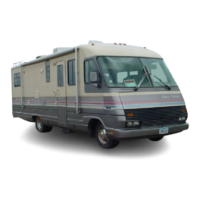ELECTRICAL
Your
motor
home has
two
electrical systems. One pro-
vides 115-volt power
to
operate
all 115-volt living area
lights and appliances. This system
is
used when power
is
available from a ground power source (see Figures 10
and 11)
or
from an on-board generator
power
plant,
if
one
is
installed. The second system uses on-board bat-
teries
to
provide
power
for all 12-volt lighting, ap-
pliances,
and accessories as well as normal vehicle needs
(see Figure 9).
115-VOLT ELECTRIC POWER
CORD
(OUTSIDE)
A 25-foot, heavy-duty, power-supply cord
is
provided
in
a special storage
compartment
(see F.igure1 0). This
cord
is
pulled
out
and
connected
'to
imy
adequate
115-
volt power source
to
activate all
power
circuits.
The
con-
nector
is
rated for 3D-amp capacity. Use
this
power
plug
only
with
the
proper mating
connector
and only
with facilities having a 3D-amp capacity.
Such
facilities
are available in most parks and campsites.
CAUTION
USING YOUR POWER CORD WITH POWER SUP-
PLIES WHICH HAVE LESS
THAN 3D-AMP CAPA·
CITY OR USING
THE PLUG WITH RECEPTACLES
FOR WHICH IT WAS NOT DESIGNED, MAY
DAM-
AGE YOUR APPLIANCES AND MAKE
THE
WAR-
RANTY INAPPLICABLE.
(Applicable to F. H, L. Models OnlY)
FIGURE
10
25-FT ELECTRIC
POWER
CORD (OUTSIDE)
11
12-VOL T SYSTEM
When the power supply cord
is
not
connected
to
a 115-
volt ground source (or
to
the
generator
power
plant
re-
ceptacle) power for lights and appliances
is
automati-
cally provided from your vehicle
battery
or
from
an aux-
iliary battery (if installed).
12-VOLT FUSES
The
fuses for
the
12-volt electrical
system
are located
for easy access (see Figure 14).
Certain models using
the
2
(INSIDE)
115-VOLT
AC
CIRCUIT
BREAKER SWITCHES
(See
Electrical Diagram
for
Additional
Fuse
Information)
1.
Junction
Box
2. 115-Volt
Reset
- Tupe Circuit Breakers
3.
Circuit Identification
(FIGURE
11)
TYPICAL ELECTRICAL
CIRCUIT
BREAKERS

